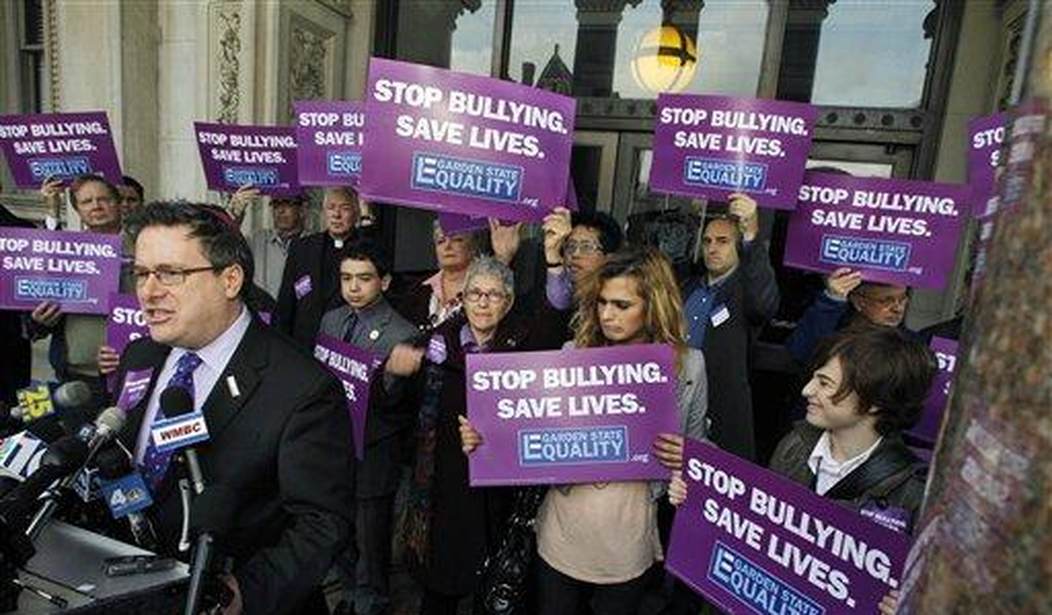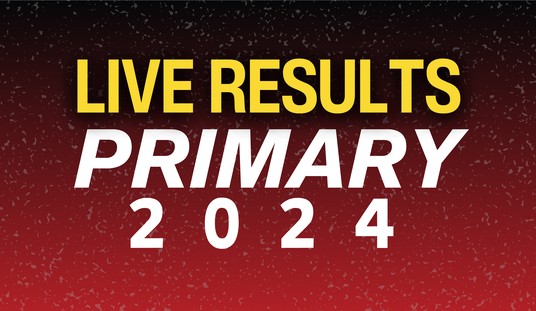Editor's note: This article originally appeared in the July issue of Townhall Magazine.
The Left is famous for championing causes and offering solutions that have very little to do with a problem. This ‘logic’ can be found in the gun control, climate change, Obamacare, government bureaucracy, and even budget debates. But one area it is prevalent that doesn’t get much attention is on the issue of bullying in schools. The federal government has spent hundreds of millions of dollars on anti-bullying campaigns in schools. Throwing more money at an issue is a typical liberal response. But it goes deeper than that. Most of the administrators and teachers that run our education system have a liberal, if not far-left, mindset. Claiming they want to solve the bullying issue in schools, they launch social media campaigns, call their celebrity friends, and ask state governments and the feds for more cash to solve the problem.
The truth is that their preferred solution, one-size-fits-all zero-tolerance policies, isn’t working. And President Obama’s drive to get the Department of Education involved in more school discipline issues is only making the problem worse.
THE NUMBERS
President Obama and first lady Michelle Obama have called on Americans to make anti-bullying a “national priority.” And in the past six years alone, Obama has pledged nearly half a billion dollars for anti-bullying campaigns.
In 2012, Democratic Texas Rep. Sheila Jackson Lee introduced the Juvenile Accountability Block Grant Re- authorization and Bullying Prevention and Intervention Act, legislation with a price tag of $40 million, according to the Congressional Budget Office. In 2009, the Department of Education’s Office of Safe and Healthy Students held its first ever Bullying Prevention Summit and has since dumped millions more into anti-bullying programs across the country.
The summit, now an annual event, was held in partnership with the Departments of Defense, Agriculture, the Interior, the Federal Trade Commission, the White House Initiative on Asian Americans and Pacific Islanders, and the National Council on Disability.
“Bullying is not just a harmless rite of passage, or an inevitable part of growing up,” former-Health and Human Services Secretary Kathleen Sebelius said at the summit in 2012. “It’s a systematic situation that threatens the health and well-being of our young people. It’s destructive to our communities and devastating to our future.”
“No one can afford to be a bystander,” she added.
What in the world do all of these random federal agencies have to do with bullying in schools? Nothing, but it’s an excuse to spend and waste taxpayer money in order to make everyone feel good about the fact that they’re doing something to solve the problem.
ZERO TOLERANCE, ZERO COMMON SENSE
On the local level, where administrations and teachers are trained to enforce zero- tolerance policies with no room for ex- planation or common sense, states with already bursting budgets have dedicated millions of dollars and resources they can’t afford to the same kinds of duplicative programs. Forty-nine states have anti-bullying laws in place that require constant marketing and training.
Recommended
When New Jersey passed its massive anti-bullying legislation in 2011, there were major concerns about the cost and how the new law would affect students. The legislation is the harshest in the nation on the issue.
“There’s no question about it: We need to do something about bullying,” Richard Bozza, executive director of the New Jersey Association of School Administrators, wrote in a Times of Trenton op-ed at the time. “But we also need to do some- thing about implementation of the new anti-bullying law. It’s costly in terms of time, money and, most important, student self-esteem.”
“Unfortunately, the law is so prescriptive, and the process so lengthy,” Bozza continued, “that it actually works to extend the bullying experience, with the potential to diminish self-esteem in the process, as students continue to relive the incident before the situation is addressed. ... The anti-bullying law also may not be appropriate for our youngest students, such as kindergartners who are just learning how to socialize with their peers. Previously, name-calling or shoving on the playground could be handled on the spot as a teachable moment, with the teacher reinforcing the appropriate behavior. That’s no longer the case. Now it has to be documented, reviewed and resolved by everyone from the teacher to the anti-bullying specialist, principal, superintendent and local board of education.”
The New York Times reported at the time of the law’s implementation that schools were having a tough time managing the resources to comply with hundreds of pages of standards. Not to mention the fact that the new anti- bullying tactics streamlined students straight past the principal’s office and into a police station.
“Under a new state law in New Jersey, lunch-line bullies in the East Hanover schools can be reported to the police by their classmates this fall through anonymous tips to the Crimestoppers hotline. In Elizabeth, children, including kindergartners, will spend six class periods learning, among other things, the difference between telling and tattling. And at North Hunterdon High School, students will be told that there is no such thing as an innocent bystander when it comes to bullying: if they see it, they have a responsibility to try to stop it,” the Times reported.
Furthermore, the costs of the program in one of America’s most heavily taxed states are enormous, even after major education reforms were signed into law by Gov. Chris Christie. Two hundred of the Garden State’s school districts were forced to spend a minimum of $2 million to implement new programs that were put together by overpaid consultants. This number was double the original budget for the implementation process.
In a survey of teachers, administrators, and school board officials, 90 percent of respondents said the legislation had increased costs and workload.
The law was introduced, passed, and signed as a typical knee-jerk reaction to the suicide of 19-year-old Tyler Clementi, which many claim was a result of repeated bullying.
THE DEFINITION PROBLEM
The very definition of “bullying” has become overly broad, however. StopBullying.gov defines the term as, “unwanted, aggressive behavior among school aged children that involves a real or perceived power imbalance. The behavior is repeated, or has the potential to be repeated, over time.”
This could be applied to almost any interaction among elementary school children. The reason the number of “bullying” cases is growing is because the term “bullying” is being applied to every instance. Basic childhood actions that were once either ignored, or handled through normal disciplinary channels, have now become a federal case.
PUNISHING THE VICTIM
While big name politicians, political appointees, and legislators tell the country that “no one can afford to be a bystander,” schools are punishing students who step in against real bullies either for themselves or for a friend.
Earlier this year NPR reported the case of De-Angelo Rollins, a middle school student in Texas who dared to punch a bully back after numerous incidents were reported to a teacher who stood by and did nothing.
“The boy ended up hitting my son in the face first,” Rollins’ mother Marjorie told the radio outlet. “My son hit him back, and they got in a little scuffle.”
Her son was punished with not only a detention, but with a criminal case, as a 12-year-old boy!
At South Fayette High School in Pennsylvania this year, a 15-year-old special needs student named Christian Stanfield, who suffers from comprehension delay disorder and anxiety, was punished by school officials for recording a bully at school. Stanfield and his mother had issued multiple reports in an attempt to get school officials to stop the poor treatment. He made the recording in order to better explain to his mother what hap- pens to him at school, a place he said he “doesn’t feel safe.”
“I had been bullied throughout the whole school year and I let them know about these incidents and my mom has emailed them the whole time and nothing’s ever been done. I felt like we weren’t being heard, I wasn’t being heard, so one day I decided to record it and it’s not like this was a spontaneous thing, this always happens every day, things like verbal threats, trying to burn me with a lighter, we’re talking about rude, irrational things,” Stanfield told Fox News’ Gretchen Carlson. “They called me down to the office and they asked to hear the recording and so I played it for them and they heard nothing. I was in a room with all the administrative teachers and principals.”
Instead of addressing and punishing the bully in the case, school officials forced Stanfield to delete the recording, punished him, accused him of wiretapping, and called the police. He was then charged criminally, convicted of disorderly conduct, and fined. In court, Stanfield told a judge he wanted his mother to see how he is really treated at school with verbal abuse and books slammed across his head.
“It certainly doesn’t make logical sense. What the school should have done is called in all of the parents, had a talk with them and let them know what was going on and tried to come up with a solution to the problem instead of trying to put this child through the criminal justice system,” Stanfield’s attorney Justin Steele said.
PUNISHING THE BYSTANDER
When adults in schools fail to stop bullying, kids have to do it themselves and they’re being severely punished in return. Ironically, many of the expensive anti-bullying campaigns put in place by the government ask parents to teach their kids to speak up when they see bullying happening to themselves, a friend, or another innocent person at school. In late 2012, under the direction of Obama, the Ad Council launched a national advertising campaign urging parents to teach their kids not to “just be a bystander.”
“Every day, kids witness bullying,” one ad states. “They want to help, but don’t know how. Teach your kids how to be more than a bystander.”
The problem is when bystanders speak, or hit back the bullies directly, they’re punished.
Zero-tolerance policies in schools leave no room for explanation and students who simply happen to be in the same area when a fight against a bully breaks out are suspended for the same amount of time as the perpetrator of the act. In return, good students who may want to speak up to bullies, don’t. The fear of being punished by their school for speaking up silences them.
Liberal academics, cowardly teachers, and the administrators who control them are creating a bigger bullying problem so they can swoop in and solve it by demanding more money. Whether they’re doing it on purpose or by default of their ideology is another question. If kids getting bullied know they’ll be punished for fighting back, even as a victim, the bullying will only continue.
DO ANTI-BULLYING CAMPAIGNS AND ZERO-TOLERANCE POLICIES EVEN WORK?
Is all this money flying out of the paychecks of taxpayers and bursting state budgets reducing bullying? Nope.
Seventy-five percent of America’s schools have zero-tolerance policies for “violent acts,” but violent acts are broadly defined and do not take self-defense into account as a category that should be exempt.
“Among disciplinary actions mandated by zero tolerance policies, suspension is most frequently used for an extensive range of common offenses, from attendance problems to disrespect and noncompliance,” a recent National Association of School Psychologists report found. “However, broad zero tolerance policies require that both minor and major disciplinary events be treated equally,” the report continued. “Zero tolerance policies are complex, costly and generally ineffective. ... There is no evidence that removing students from school makes a positive contribution to school safety.” (Emphasis added)
And NASP isn’t alone in their finding or stance.
University of Texas at Arlington criminologist Seokjin Jeong has done extensive research on the effectiveness of anti-bullying policies and campaigns. In 2013, Jeong collected data from 50 states and 7,000 students. After analyzing the data, he found that anti-bullying policies weren’t only failing to prevent bullying, but they were also putting students into a more likely position to be bullied. Further, he found that expensive anti-bullying training materials designed to educate students about bullying often just taught existing bullies new ways to bully rather than teaching kids anything new about stepping in to stop a situation from occurring.
Zero-tolerance policies are also a lazy way to discipline, requiring hardly any thought from adults about how to handle a situation among children, or between a bully and a child. These policies also tie the hands of teachers and put all of the power of discipline into the hands of administrators.
A BETTER WAY
Punishing misbehavior is important and so is punishing the right person, not the victim. Jeong also found through his research that schools without anti-bullying, zero-tolerance policies had the least amount of bullying.
Expansive pieces of anti-bullying legislation, zero-tolerance policies, and more money won’t stop bullying, but allowing students to defend themselves and allowing teachers to use common sense to address a “violent” situation, will. Big Government always exacerbates a problem and bullying is no exception. •

























Join the conversation as a VIP Member